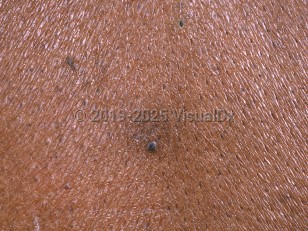Epidermolytic acanthoma
Alerts and Notices
Important News & Links
Synopsis

Epidermolytic acanthoma is an uncommon, benign, acquired, asymptomatic lesion that typically arises at or after middle age. It usually presents in a solitary fashion but may present as multiple or disseminated discrete lesions. It is slightly more common in men and characteristically appears as a hyperkeratotic papule on the trunk or extremities. Epidermolytic acanthomas have, however, been reported in various locations, including the face and genitalia. The majority of cases of multiple lesions have been reported in the genital region, primarily the scrotum. In addition, lesions may present as linear plaques rather than solitary papules, and this has been reported in the vulvar region.
Epidermolytic acanthoma histopathologically reveals epidermolytic hyperkeratosis that involves either the entire thickness of the epidermis or just the granular and upper spinous layers. Epidermolytic hyperkeratosisis a process that leads to (or is associated with) aberration of epidermal maturation. It is seen in a variety of both localized and generalized genetic and acquired conditions, including bullous congenital ichthyosiform erythroderma, Vorner palmoplantar keratoderma, and systemized or linear epidermal nevi, among others. When this disorder of the epidermis occurs as solitary or multiple forms of epidermolytic acanthoma, it is considered to be an isolated entity that is not associated with other cutaneous or systemic conditions.
The pathogenesis of epidermolytic acanthoma is unknown, but some hypotheses hold that mutations in keratins 1 and 10 caused by external factors such as ultraviolet radiation, immunosuppression, or repeated trauma (such as scratching) may be responsible.
Epidermolytic acanthoma histopathologically reveals epidermolytic hyperkeratosis that involves either the entire thickness of the epidermis or just the granular and upper spinous layers. Epidermolytic hyperkeratosisis a process that leads to (or is associated with) aberration of epidermal maturation. It is seen in a variety of both localized and generalized genetic and acquired conditions, including bullous congenital ichthyosiform erythroderma, Vorner palmoplantar keratoderma, and systemized or linear epidermal nevi, among others. When this disorder of the epidermis occurs as solitary or multiple forms of epidermolytic acanthoma, it is considered to be an isolated entity that is not associated with other cutaneous or systemic conditions.
The pathogenesis of epidermolytic acanthoma is unknown, but some hypotheses hold that mutations in keratins 1 and 10 caused by external factors such as ultraviolet radiation, immunosuppression, or repeated trauma (such as scratching) may be responsible.
Codes
ICD10CM:
D23.9 – Other benign neoplasm of skin, unspecified
SNOMEDCT:
733892008 – Epidermolytic acanthoma
D23.9 – Other benign neoplasm of skin, unspecified
SNOMEDCT:
733892008 – Epidermolytic acanthoma
Look For
Subscription Required
Diagnostic Pearls
Subscription Required
Differential Diagnosis & Pitfalls

To perform a comparison, select diagnoses from the classic differential
Subscription Required
Best Tests
Subscription Required
Management Pearls
Subscription Required
Therapy
Subscription Required
References
Subscription Required
Last Updated:02/26/2020
Epidermolytic acanthoma

